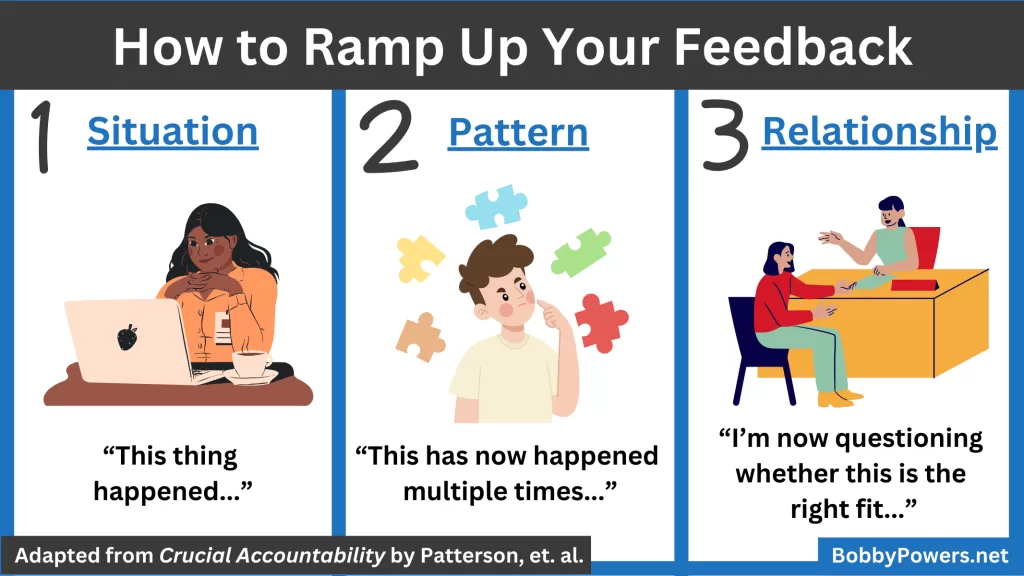What to Do If You Give Feedback and Your Employee Still Doesn’t Change
I didn’t want to fire Ron, but I felt like I had no choice.
My company had just promoted me to manage the team I had worked on for the past year. Our six-person team was performing well except Ron (pseudonym).
Ron was an awesome guy — friendly, optimistic, and helpful. There was only one problem: Ron really struggled with the daily work.
No matter how many times his colleagues and I explained the technical aspects of the job to him, Ron kept making mistakes. The lessons didn’t stick.
As Ron’s manager, I felt stuck because no matter how often I gave Ron training or feedback, he kept making the same mistakes. I ran out of things to say and felt like I didn’t have a good way of ramping up my feedback.
My situation with Ron was almost a decade ago, and since then, I’ve gotten to learn from many similar situations — both as a manager and as a trainer.
Over the past six years, I’ve trained over 100 managers in my role as director of learning & development (L&D). I also discovered a helpful three-step process for delivering feedback when the message isn’t getting through or someone isn’t making the changes you had hoped.
The 3-Step Process: Situation, Pattern, Relationship
This process is adapted from the book Crucial Accountability, written by Kerry Patterson and several others from the Crucial Learning team.

1. SITUATION: The first time someone makes a mistake…
If one of your direct reports messes up, it’s your job to give them feedback. And the majority of that feedback should be low-stakes, everyday stuff:
- “I noticed you completed this project a day late…”
- “You struggled to answer the prospective client’s question on that call…”
- “You showed up to work 15 minutes late today…”
All of this feedback refers to one specific situation: one time your direct report did or didn’t do something.
As a manager, you should give your team members feedback (both positive and constructive) almost every single day. Employees want to do great work, and if you tell them how to improve, the majority of them will immediately try to fix the problem you observed.
2. PATTERN: After they’ve made the same mistake several times…
The vast majority of the time, if someone makes a mistake and you share feedback, they’ll address the issue and you’ll never have to discuss it again.
But unfortunately, that doesn’t happen every time. Sometimes, you give the person feedback, then you see the same issue happen again the following week — or even the following day.
It’s important to remember that behavior change is difficult. Even if someone wants to change, it may take them a little while to tweak what they’re doing. You should extend grace to the person who’s trying to improve, especially if they’re trying to address something that is deeply ingrained (e.g., avoiding “ah” and “um” in public speeches, asking better questions on client calls, improving their problem-solving skills).
But there are plenty of other situations where the expected performance change is much more within the person’s immediate realm of control: showing up on time, treating others with respect, following through on commitments, completing assignments on time, etc. In many situations like these, the employee should (hopefully) be able to pivot and quickly improve in the area you observed.
If you give someone feedback about one of these types of situations and they continue making the same mistake, you need to approach the conversation differently the next time.
Rather than talking about the situation, you need to begin talking about the pattern. Candidly tell the employee that you’ve now seen the same thing happen multiple times. Remind them you’ve chatted about this same issue before and they haven’t improved.
Here’s what your Step #2 conversation may sound like:
- “We talked about this issue last week, but now it happened again. It seems like this is a recurring problem…”
- “Do you remember our conversation a month ago about this topic? I’m worried that there’s now a pattern of you making the same mistake and not listening to feedback. What do you think is preventing you from improving in this area? How can I help?”
By talking about the recurring pattern of multiple situations, you slowly begin to ramp up the feedback and show them that the topic is serious.
3. RELATIONSHIP: If it keeps happening, no matter what you do…
If I had to guess, I’d estimate that 90 percent of the time when you give someone feedback, Step #1 (discussing the situation) resolves the issue. And for those issues that make it to a Step #2 conversation (discussing the pattern), probably 90 percent of those never make it to Step #3.
In other words, you shouldn’t need to conduct many Step #3 conversations.
But unfortunately, as any manager knows, sometimes things don’t work out the way we hope. Occasionally, you’ll give someone feedback and the problem keeps happening…and happening…and happening.
In those situations, it’s important to take the conversation even further with your direct report. And the best way to do that is to begin talking about the overall relationship: whether the role/company is the best fit for them.
Here’s what this Step #3 conversation could sound like:
- “We’ve now discussed this issue several times, and I’m beginning to question whether our company is the best place for you to build a career…”
- “As you know, we’ve talked about this same issue a few times before. I’m now wondering whether this company is the right fit for you. If you’re unable to improve your performance, we may need to let you go.”
I know this type of conversation is SCARY! Every time I know I’ll have to deliver feedback like this, I lose sleep the night before. (Even writing the candid lines of dialogue above made me cringe.)
But as a manager, it’s important to remember two things:
- As Brené Brown says, “Clear is kind. Unclear is unkind.”
- If the employee may get fired soon, it’s in their best interest to begin researching other jobs rather than getting terminated out of nowhere with no backup plan.
When I train managers, I tell them they should never fire someone without first saying the words, “If this behavior doesn’t improve, you’re going to lose your job.” You must be transparent. You must be direct.
Giving critical feedback is one of the toughest aspects of being a manager. It’s especially difficult if the employee doesn’t improve even after you’ve delivered feedback.
By following this 3-step model, you can clearly and concisely raise the stakes of the conversation and (ideally) help your employee improve:
- Situation: “This thing happened…”
- Pattern: “This has now happened multiple times…”
- Relationship: “I’m now questioning whether this is the right fit…”
Want to become a stronger leader?
Sign up to get my exclusive
10-page guide for leaders and learners.




